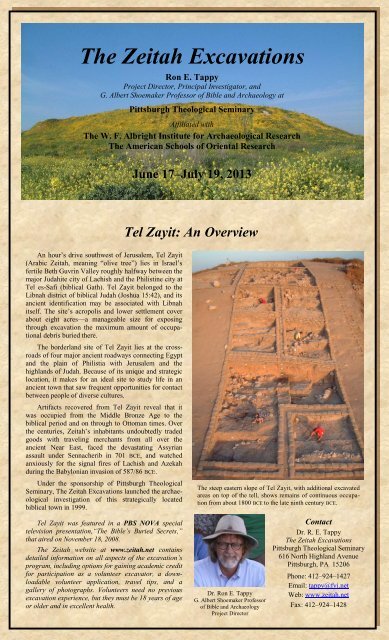2013 Brochure - The Zeitah Excavations
2013 Brochure - The Zeitah Excavations
2013 Brochure - The Zeitah Excavations
You also want an ePaper? Increase the reach of your titles
YUMPU automatically turns print PDFs into web optimized ePapers that Google loves.
<strong>The</strong> <strong>Zeitah</strong> <strong>Excavations</strong><br />
Ron E. Tappy<br />
Project Director, Principal Investigator, and<br />
G. Albert Shoemaker Professor of Bible and Archaeology at<br />
Pittsburgh <strong>The</strong>ological Seminary<br />
Affiliated with<br />
<strong>The</strong> W. F. Albright Institute for Archaeological Research<br />
<strong>The</strong> American Schools of Oriental Research<br />
An hour’s drive southwest of Jerusalem, Tel Zayit<br />
(Arabic <strong>Zeitah</strong>, meaning “olive tree”) lies in Israel’s<br />
fertile Beth Guvrin Valley roughly halfway between the<br />
major Judahite city of Lachish and the Philistine city at<br />
Tel es-Safi (biblical Gath). Tel Zayit belonged to the<br />
Libnah district of biblical Judah (Joshua 15:42), and its<br />
ancient identification may be associated with Libnah<br />
itself. <strong>The</strong> site’s acropolis and lower settlement cover<br />
about eight acres—a manageable size for exposing<br />
through excavation the maximum amount of occupational<br />
debris buried there.<br />
<strong>The</strong> borderland site of Tel Zayit lies at the crossroads<br />
of four major ancient roadways connecting Egypt<br />
and the plain of Philistia with Jerusalem and the<br />
highlands of Judah. Because of its unique and strategic<br />
location, it makes for an ideal site to study life in an<br />
ancient town that saw frequent opportunities for contact<br />
between people of diverse cultures.<br />
Artifacts recovered from Tel Zayit reveal that it<br />
was occupied from the Middle Bronze Age to the<br />
biblical period and on through to Ottoman times. Over<br />
the centuries, <strong>Zeitah</strong>’s inhabitants undoubtedly traded<br />
goods with traveling merchants from all over the<br />
ancient Near East, faced the devastating Assyrian<br />
assault under Sennacherib in 701 BCE, and watched<br />
anxiously for the signal fires of Lachish and Azekah<br />
during the Babylonian invasion of 587/86 BCE.<br />
Under the sponsorship of Pittsburgh <strong>The</strong>ological<br />
Seminary, <strong>The</strong> <strong>Zeitah</strong> <strong>Excavations</strong> launched the archaeological<br />
investigation of this strategically located<br />
biblical town in 1999.<br />
Tel Zayit was featured in a PBS NOVA special<br />
television presentation,“<strong>The</strong> Bible’s Buried Secrets,”<br />
that aired on November 18, 2008.<br />
<strong>The</strong> <strong>Zeitah</strong> website at www.zeitah.net contains<br />
detailed information on all aspects of the excavation’s<br />
program, including options for gaining academic credit<br />
for participation as a volunteer excavator, a downloadable<br />
volunteer application, travel tips, and a<br />
gallery of photographs. Volunteers need no previous<br />
excavation experience, but they must be 18 years of age<br />
or older and in excellent health.<br />
June 17–July 19, <strong>2013</strong><br />
Tel Zayit: An Overview<br />
<strong>The</strong> steep eastern slope of Tel Zayit, with additional excavated<br />
areas on top of the tell, shows remains of continuous occupation<br />
from about 1800 BCE to the late ninth century BCE.<br />
Dr. Ron E. Tappy<br />
G. Albert Shoemaker Professor<br />
of Bible and Archaeology<br />
Project Director<br />
Contact<br />
Dr. R. E. Tappy<br />
<strong>The</strong> <strong>Zeitah</strong> <strong>Excavations</strong><br />
Pittsburgh <strong>The</strong>ological Seminary<br />
616 North Highland Avenue<br />
Pittsburgh, PA 15206<br />
Phone: 412–924–1427<br />
Email: tappy@fyi.net<br />
Web: www.zeitah.net<br />
Fax: 412–924–1428
West Semitic Research<br />
An overlay of the twenty-two-letter Tel Zayit abecedary shows the tenth-century<br />
BCE forms that were incised into the stone itself.<br />
Season’s Preview <strong>2013</strong><br />
June 17–July 19, <strong>2013</strong><br />
In 2009, the <strong>Zeitah</strong> team located burned<br />
debris from the destruction of Tel Zayit during<br />
the Assyrian military campaign of Sennacherib<br />
through the Shephelah in 701 BCE—the time<br />
of King Hezekiah (see 2 Kings 18–20 and<br />
Isaiah 36–37). Work during the <strong>2013</strong> Season<br />
will focus on Square K20, located on the tell’s<br />
western summit. This year, our goal will be to<br />
penetrate below the previously exposed<br />
Roman, Hellenistic, and Persian deposits in<br />
order to reach levels that we can associate with<br />
the Assyrian destruction identified in other<br />
areas of the site. <strong>The</strong> results of this work will<br />
enhance our understanding of the history of<br />
both the site and the region during the Iron Age<br />
IIB period.<br />
During each excavation season, the <strong>Zeitah</strong><br />
team resides at nearby Kibbutz Galon, located<br />
in one of the most beautiful regions of Israel—<br />
the foothills of biblical Judah.<br />
<strong>The</strong> Tel Zayit<br />
Abecedary<br />
On the final day of the 2005<br />
season, <strong>The</strong> <strong>Zeitah</strong> <strong>Excavations</strong> made a<br />
dramatic discovery: a twenty-two-letter<br />
inscription bearing the oldest known<br />
securely datable example of the complete<br />
linear alphabet. <strong>The</strong> letters represent<br />
a transitional script that developed<br />
from earlier Phoenician traditions and<br />
anticipated the distinctive features of<br />
the mature Hebrew national script.<br />
All successive alphabets (including<br />
non-Semitic ones, such as Greek and<br />
Latin) derive from the forms seen here.<br />
<strong>The</strong> importance of this discovery<br />
lies not only in its archaic alphabetic<br />
text, called an “abecedary,” but also in<br />
the stone’s firmly datable archaeological<br />
context (tenth century BCE)—an<br />
extremely rare occurrence among the<br />
few extant inscriptions of this nature.<br />
<strong>The</strong> Tel Zayit abecedary was inscribed with an extremely fine,<br />
probably iron point into a limestone boulder (shown above in situ).<br />
<strong>The</strong> boulder was later incorporated into the wall of a building, with<br />
the inscribed side facing the interior of a stone-paved room.<br />
A bowl-shaped hollow ground<br />
into the opposite side of the 38pound<br />
boulder bearing the Tel<br />
Zayit Inscription added another<br />
intriguing element to the stone’s<br />
significance for the 2005 team.


